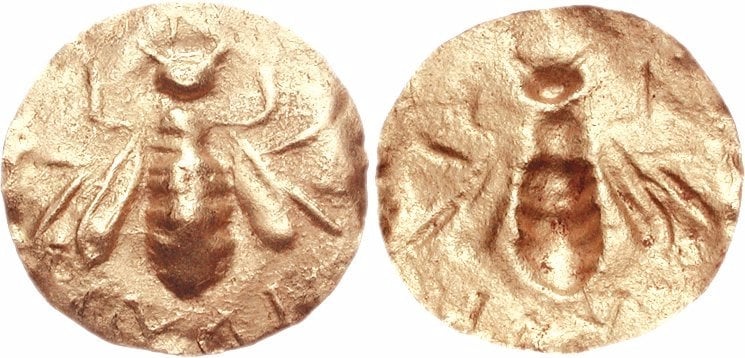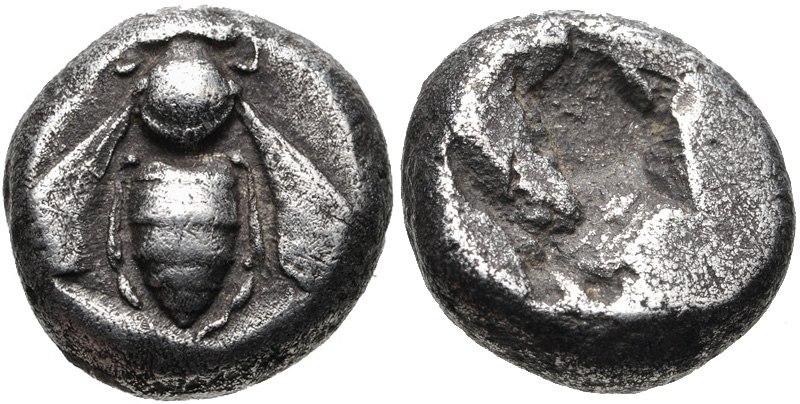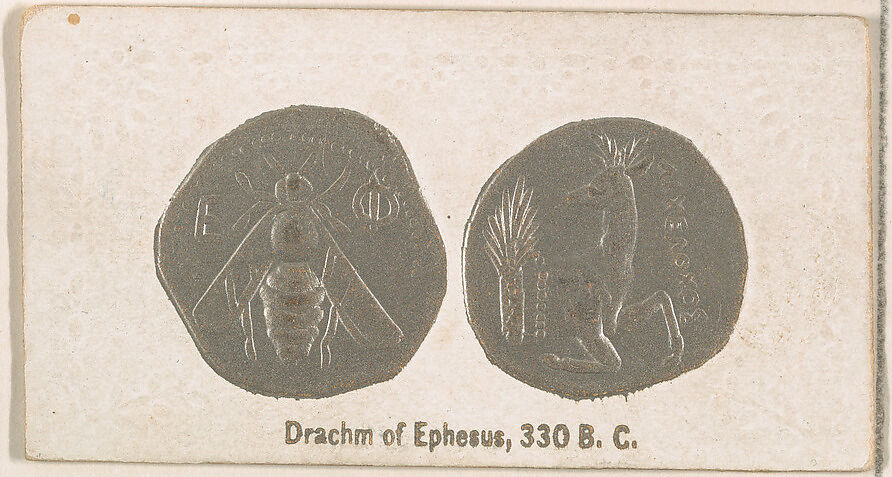
Depictions of the bee appear very early in the development of coinage in ancient Greece, with Ephesus, an ancient city in Ionia (Aegean coast of Asia Minor), having a particular claim to the tradition after it adopted the insect as its civic emblem. Bees were also depicted in jewelry and statues of goddesses in ancient Greece.
Centuries before people formed agrarian societies, relying on agriculture in settled communities, honey gathered from the hives of wild bees was valued as a precious substance. Being that the honeybee is native to the lands surrounding the Mediterranean Sea, domestication of this pollinator was crucial for the growth of many fruit crops in the region.
Such was the value of honey as a commodity that the Egyptian hieroglyph for ‘bee’ came to be used as the symbol for the ruler of Lower Egypt.
In ancient Greece, bees and honey were a significant symbol, often linked with knowledge, health, and power. The insects were even considered servants of the gods, with honey being worshipped for its healing attributes.
The goddess of the bees in ancient Greece was Melissa. According to Greek mythology, a nymph had revealed to her the use of honey by the bees themselves. She was one of the nymph nurses to Zeus when he was born to Rhea in a cave that was supposedly sacred to bees. There are two versions of the myth, one stating that the bees nurtured Zeus, with his son then nurtured by the Melissae (priestesses in the temples of the goddesses), and another saying that it was Zeus who was fed with the milk of goats and with honey by the Melissae.
The bee on the coinage of Ephesus in ancient Greece
The ancient Greek city of Ephesus was the location of a famous temple of Artemis, and the high priest of the temple was known as the “king bee.” There are nearly a thousand different known types of bee-and-stag coins from the city, and unpublished new types appear frequently. One of the earliest known examples is a rare electrum hemistater, dated to around 550 BC, which was sold for 25,000 dollars at a US auction in 2015.

Bees possess two pairs of wings, but typical representations of the insect in ancient times generally only showed one pair with the early exception of a silver obol of Ephesus from around 550 BC. It showed all four wings. Early in the classical era (480-450 BC), bees depicted on silver drachms from Ephesus were etched with curved wings and curly antennae, giving the insect a cartoon-like appearance.
By the fourth century BC in ancient Greece, Ephesian die-cutters, having advanced in their art, were engraving much more realistic bees, which included details like the sting, jointed legs, and the segmented abdomen.

Some of the coins, popular with collectors, are inscribed with the abbreviated name Ephesus (E-Φ) on one side, and on the other, alongside the stag, the name of the then-magistrate is spelled out.
In 356 BC, the Temple of Artemis was burned down. Several sources from the time claim this was the doing of Herostratus, who supposedly set fire to the wooden roof-beams, seeking fame at any cost and giving rise to the term “herostratic fame.” Over the following centuries, the structure was repeatedly demolished and rebuilt, and in the background, the city continued to issue civic coinage bearing the bee and stag until around 133 BC.
The bee begins to disappear from the coinage of Ephesus after the city became part of the Roman empire, a society in which the emperor appears on the coins, leaving no room for the insect.
Other Greek cities where the bee appeared
Several other cities in ancient Greece adopted the image of a bee for their coins, possibly signifying economic ties with Ephesus or the hosting of a local cult of Ephesian Artemis. The side angle of the bee, as seen in Egyptian hieroglyphs, is very rarely seen on ancient coins, but it does appear on a very small hemiobol from an unknown Ionian mint, along with a turtle on the reverse.
The insects also occasionally appeared as decorations on ancient coin-like items, or tokens, such as one gold disc which was not dated but sold in a 2007 US auction. One theory is that these disc objects have magic powers, and they were buried with the dead to pay Charon, the boatman who ferried souls to the afterlife.

In around 202 BC, Ephesus forged an alliance with the Phoenician city of Arados (present day Arwad, a small island off the Syrian coast south of Tartus). Arados later marked this partnership by taking on the bee and stag design for its coinage, and the coins of Arados can be distinguished by the word Aradion, inscribed in Greek on one side. It is thought that this alliance lasted for some time.
A number of other towns in ancient Greece adopted the bee, too, such as Gentinos, a small town in the region of Troas (northwest Anatolia), which used a bee and palm tree on its fourth century BC bronze.
Praisos, an ancient city on the island of Crete, put a bee with a rose on the reverse of a rare silver hemidrachm around the fourth to third centuries BC, and another Cretan town, Elyros, had the image of an atypically detailed bee—particularly the veins on its wings—on its silver drachm around 300 to 270 BC. The relatively unknown town of Iulis on the present-day island of Kea also placed a bee on the reverse of its third century BC bronze coinage.
The beehive is surprisingly rare on ancient coins. The city of Deultum in Thrace (now Burgas on the Black Sea coast of Bulgaria) depicted a beehive on one side of its rare local bronze coins, issued during the mid-third century.
See all the latest news from Greece and the world at Greekreporter.com. Contact our newsroom to report an update or send your story, photos and videos. Follow GR on Google News and subscribe here to our daily email!



